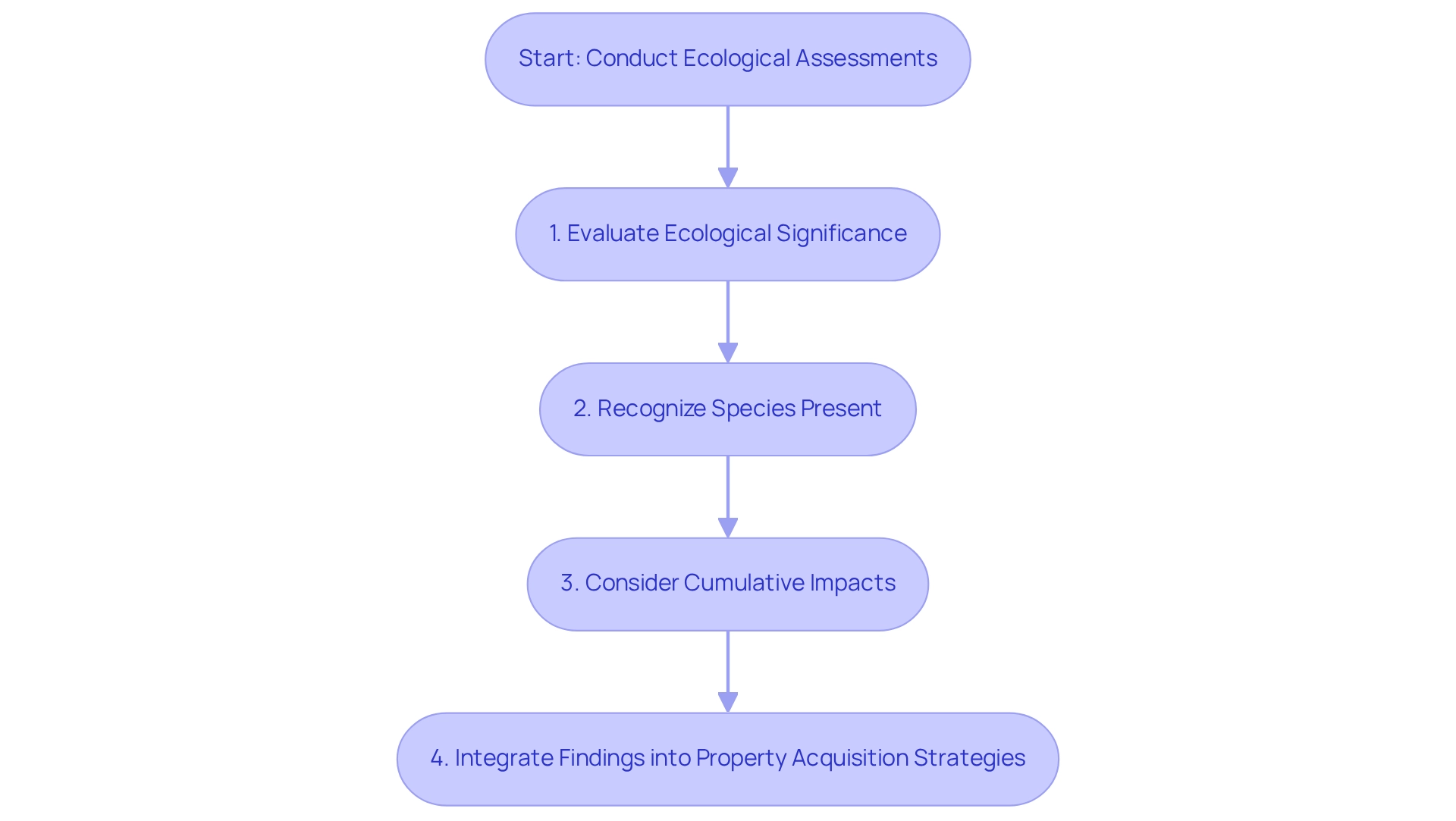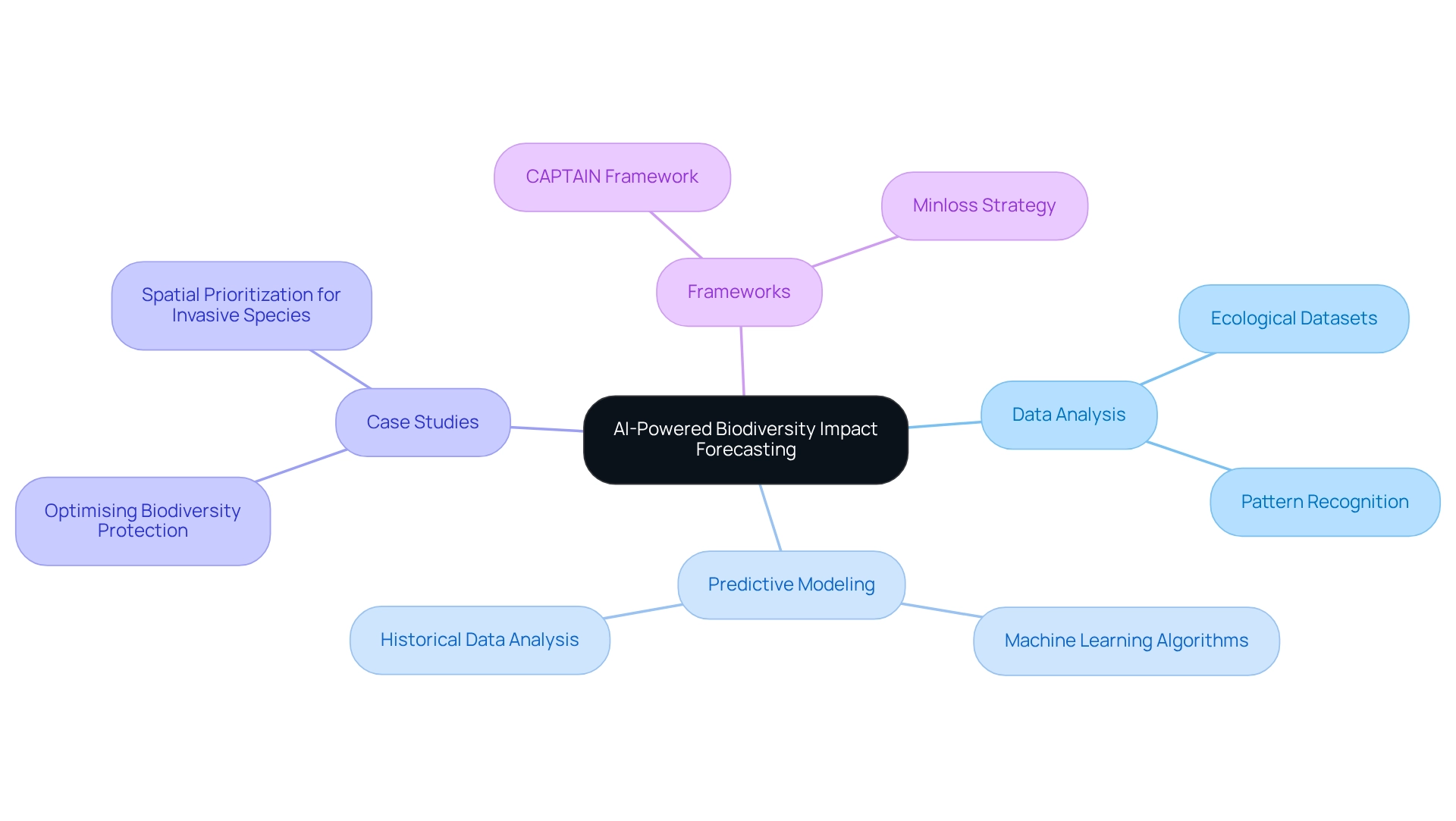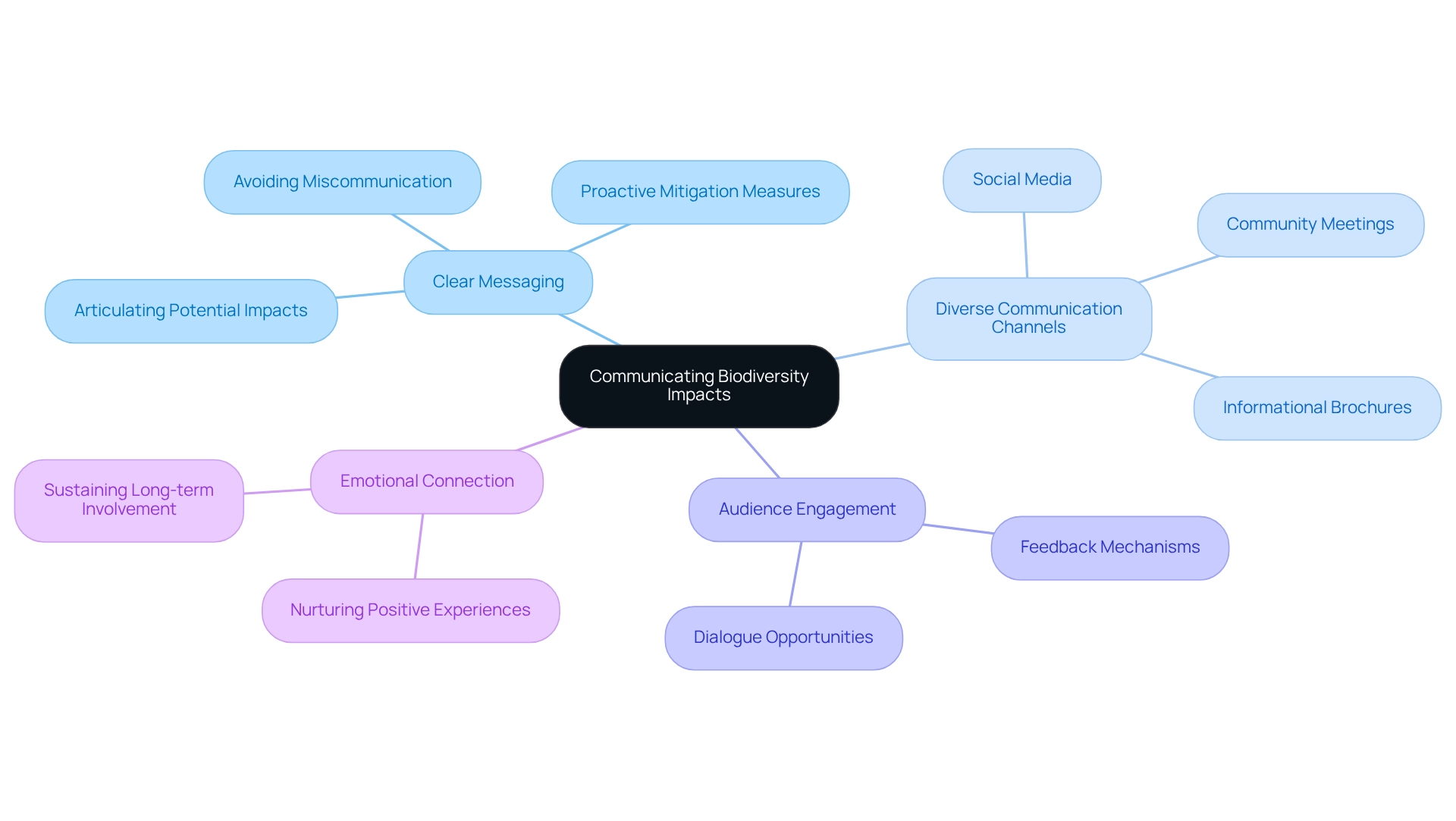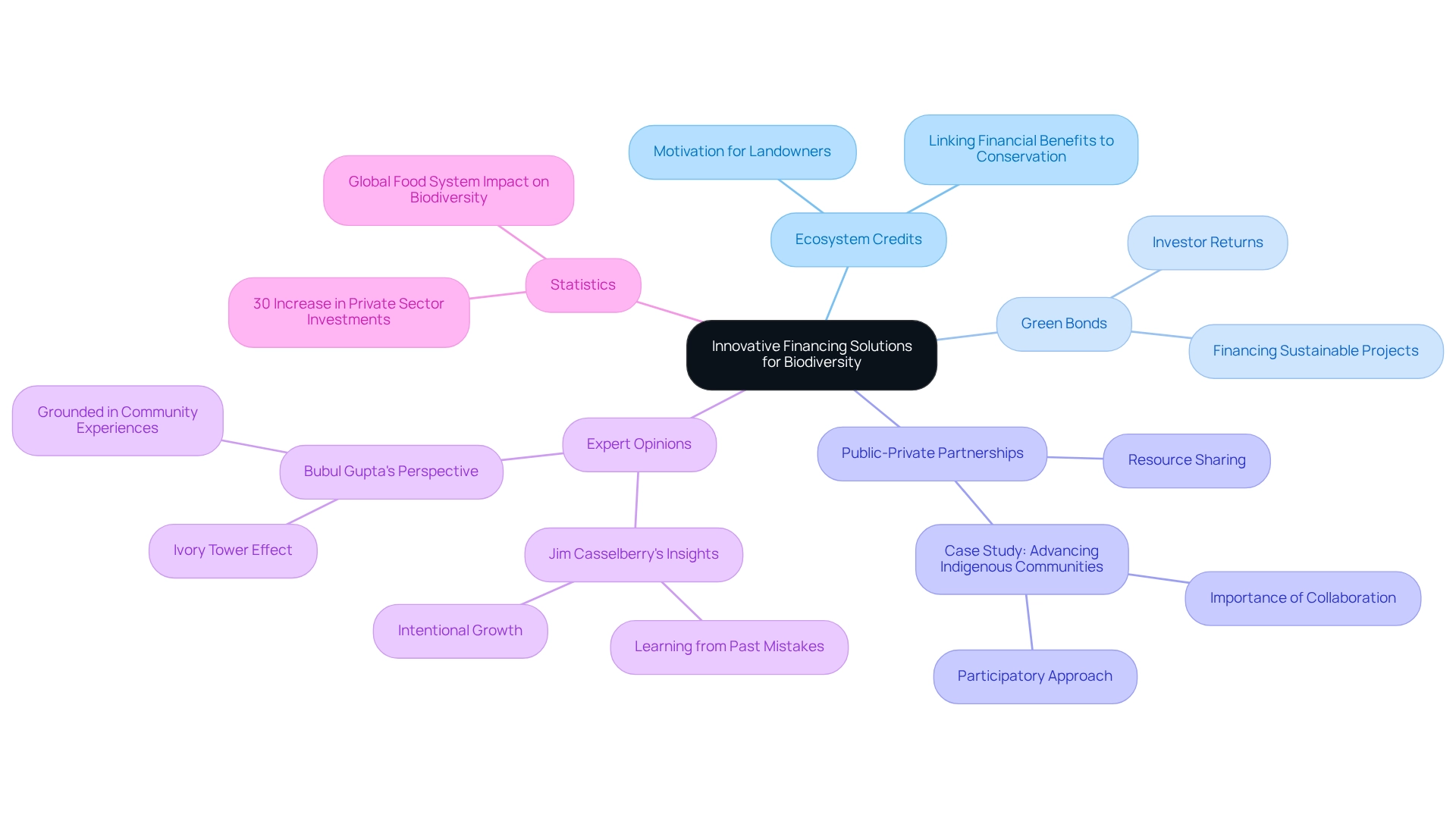Overview
The article presents seven strategies for effective biodiversity impact forecasting, emphasizing the integration of advanced technologies, stakeholder engagement, and regulatory compliance to enhance ecological assessments. These strategies are substantiated by evidence demonstrating how AI tools, ecological evaluations, and community involvement can refine decision-making processes. By promoting sustainable land acquisition practices, these approaches ultimately aim to protect biodiversity amid pressing environmental challenges.
Introduction
In a world increasingly aware of the delicate balance between development and ecological preservation, the role of land services in energy and infrastructure projects is critical. Companies like Harbinger Land lead the way, providing comprehensive solutions that streamline site and right-of-way acquisition while integrating advanced technologies to enhance operational efficiency.
As biodiversity risks grow due to climate change and habitat destruction, understanding the implications for land acquisition strategies becomes paramount. This article explores the multifaceted approaches needed to navigate these challenges.
- How can organizations leverage AI-powered tools for accurate biodiversity impact forecasting?
- Engaging stakeholders in meaningful dialogues is essential.
- By examining innovative financing solutions and the importance of regulatory compliance, we highlight the necessity of integrating biodiversity considerations into corporate responsibility practices.
As the landscape of land acquisition evolves, staying ahead of emerging trends is essential for fostering sustainable development and protecting our planet's precious ecosystems.
Harbinger Land: Comprehensive Solutions for Land Services in Energy and Infrastructure
Harbinger Land stands at the forefront of customized property services tailored for energy and infrastructure projects. We specialize in site and right-of-way acquisition, title research, GIS mapping, and data processing. The complexities of land acquisition, including legal and regulatory challenges, can be daunting. Our expert team adeptly negotiates and secures the necessary leases and easements for distributed energy resources (DER) and infrastructure development. By leveraging highly integrated GIS modeling services, we save clients both time and money.
Harnessing advanced technologies, such as AI-powered title research software and efficient document imaging solutions, we significantly enhance operational efficiency and client satisfaction. This technological edge is crucial in enhancing biodiversity impact forecasting; effective resource management strategies can mitigate adverse effects on local ecosystems and foster sustainable development practices. Moreover, our commitment to integrating innovative solutions and robust security measures for protecting financial data positions Harbinger as a leader in promoting responsible resource use. We address the pressing challenges of energy and infrastructure development with confidence and expertise. Are you ready to partner with us and navigate the complexities of land acquisition effectively?
Understanding Biodiversity Risks: Implications for Land Acquisition Strategies
Biodiversity risks pose significant challenges, stemming from factors such as habitat destruction, pollution, and climate change. These elements profoundly influence property acquisition strategies. To navigate these complexities, conducting thorough ecological assessments is essential for biodiversity impact forecasting to identify potential impacts on local ecosystems. This process involves:
- Evaluating the ecological significance of the area
- Recognizing the species present
- Considering the cumulative impacts of development activities
For instance, a study examining consumptive water use in wetlands revealed substantial losses in biological diversity, particularly among at-risk species. This underscores the urgent need for improved water management practices in property acquisition. Furthermore, fossil-based ethanol contributes GHG emissions of 3.7 kg CO2 equivalent per kg, highlighting the broader implications of climate change on ecosystems and resource acquisition strategies.
By integrating ecological risk evaluations into their strategies, companies can make informed decisions that align with sustainability goals and comply with regulatory frameworks. As Wencke Müller-Rilke, BMZ Governance Focal Point, noted, "Germany’s commitment to being a reliable partner for fair resource management" reflects the global efforts required in this domain. Continuous research is also vital to validate and enhance species variety evaluation techniques, ensuring that property acquisition strategies remain effective.
As climate change continues to alter habitats, biodiversity impact forecasting becomes increasingly critical for understanding these risks, effective property acquisition, and long-term ecological preservation. New conservation frameworks (CFs) can assist decision-makers in measuring, contrasting, and potentially reducing the ecological impact of products, further promoting sustainable property acquisition practices.

Leveraging AI-Powered Tools for Accurate Biodiversity Impact Forecasting
AI-driven tools are revolutionizing biodiversity impact forecasting by facilitating precise data analysis and predictive modeling. These advanced technologies can scrutinize extensive ecological datasets, uncover patterns, and facilitate biodiversity impact forecasting to simulate the potential effects of land use changes on biological diversity.
For instance, machine learning algorithms have been effectively employed to analyze historical data, allowing for predictions regarding how specific developments may affect local species and habitats. A notable case study illustrated that a novel framework, which integrates simulation models and reinforcement learning, could significantly enhance environmental policies, safeguarding more species from extinction under fixed budgets compared to traditional methods.
This framework, as underscored in the study 'Optimising ecosystem protection through artificial intelligence,' reveals that regular ecological monitoring, when paired with AI tools, leads to improved conservation outcomes. Furthermore, statistics indicate that the CAPTAIN framework can be applied to extensive, real-world tasks, underscoring the scalability and effectiveness of AI in ecological evaluations.
As we advance into 2025, the application of machine learning in ecological assessments continues to yield successful results, exemplified by the minloss strategy's effectiveness in managing invasive species, which reduces future infestations by 15%. By integrating these advanced tools into ecological evaluations, organizations can bolster their planning processes, optimize resource allocation, and ensure compliance with environmental regulations.
As Elon Musk remarked, "We will have for the first time something smarter than the smartest human," emphasizing the transformative potential of these technologies in promoting sustainable land use practices.

Engaging Stakeholders: Building Consensus for Biodiversity Conservation
Involving stakeholders is essential for the effective conservation of biological diversity. This process necessitates the identification of all relevant parties, including local communities, government agencies, and environmental organizations, while fostering open dialogues to address their concerns and expectations. Effective stakeholder involvement can yield collaborative solutions that align development projects with ecological preservation. Strategies such as workshops, public consultations, and participatory planning are vital for building trust and consensus.
For instance, the more4nature project exemplifies this approach by enhancing citizen science initiatives across various regions, supporting over 160 initiatives and 95 authorities. This project underscores the significance of community involvement, as it aims to ensure the effective implementation of environmental protection policies through citizen-generated data.
Statistics reveal that while ecological management strategies are prioritized, public engagement efforts often rank lower, highlighting the necessity for a balanced approach. As Jens Newig emphasizes, "Take into account the specific circumstances surrounding the decision-making process to make informed choices in designing and running a (participatory) environmental decision-making process." By prioritizing open discussions with local communities and organizations, stakeholders can develop more effective strategies for protecting ecosystems that reflect the social dimensions of these projects. Furthermore, the effectiveness of public consultations in environmental projects should not be underestimated, as they play a crucial role in fostering community involvement and ensuring that diverse perspectives are considered.
Navigating Regulatory Frameworks: Compliance and Biodiversity Considerations
Navigating the complex regulatory structures overseeing ecosystem preservation is essential for organizations involved in land acquisition. Adherence to numerous laws at local, state, and federal levels is critical, as these regulations dictate the necessity of incorporating biodiversity impact forecasting into project planning. Key components include environmental impact assessments (EIAs), habitat conservation plans, and species protection laws, all of which significantly influence project outcomes.
Statistics reveal that compliance rates with environmental regulations are alarmingly low, with many organizations struggling to meet the requirements established by governing bodies. Notably, the extraction and processing of natural resources, particularly in agriculture, account for 90% of the loss of biological diversity, according to the UN's International Resource Panel. However, compliance with these regulations not only mitigates risks but also bolsters a company's reputation as a responsible environmental steward.
Recent advancements, such as the Global Biodiversity Framework (GBF), highlight the growing emphasis on biodiversity impact forecasting, urging businesses to assess their impacts and reliance on natural systems. This framework mandates that large corporations engage in biodiversity impact forecasting by disclosing their effects on ecosystems and their dependencies by 2030, aiming to standardize ecological reporting and prepare organizations for increased accountability.
Moreover, effectively navigating environmental impact assessments can yield more sustainable project outcomes. Firms that engage actively in these evaluations often find they can identify potential ecological risks early in the planning phase, facilitating more informed decision-making. As Aldo Leopold aptly stated, "We can be ethical only in relation to something we can see, feel, understand, love, or otherwise have faith in." This quote underscores the connection between humans and nature, emphasizing the ethical obligation organizations have towards biodiversity.
In summary, understanding and adhering to ecological regulations is not merely a legal obligation; it is a strategic advantage that can promote long-term sustainability and operational success in land acquisition projects. The challenges and opportunities that businesses encounter in addressing environmental risks further underscore the significance of these compliance efforts.
Communicating Biodiversity Impacts: Strategies for Effective Stakeholder Engagement
Effectively conveying the effects on ecosystems is crucial for obtaining stakeholder backing and promoting transparency in conservation initiatives. Organizations must craft clear messaging that articulates the potential impacts of their projects on local ecosystems, alongside the proactive measures implemented to mitigate these effects. Understanding audience associations with specific words and images is essential to avoid miscommunication and enhance engagement.
How can organizations ensure their messaging resonates with diverse stakeholders?
Employing a variety of communication channels—such as social media, community meetings, and informational brochures—can effectively engage diverse audiences. Furthermore, creating avenues for feedback and dialogue significantly enhances stakeholder trust and engagement.
Studies indicate that without a cohesive vision, the expense of preserving ecological diversity can rise to AUD$28.5 million each year. Lowering barriers to action can facilitate the translation of motivation into concrete behaviors, fostering a more engaged stakeholder base.
Additionally, findings from the case study titled 'The Role of Positive Emotions in Sustaining Action' emphasize that nurturing positive emotional experiences is crucial for sustaining long-term involvement and facilitating transformative change in environmental initiatives. By emphasizing transparency and nurturing positive emotional connections, organizations can maintain long-term involvement and promote transformative change in environmental conservation initiatives.
As Josie Carwardine from CSIRO Land and Water underscores, effective communication is vital for project success, highlighting the necessity for thorough conceptualization and clear messaging.

Measuring Biodiversity Impacts: Tools and Techniques for Accurate Assessment
Biodiversity impact forecasting necessitates a multifaceted approach that integrates both qualitative and quantitative evaluation tools. Methods such as ecological indices, habitat evaluations, and species tracking yield essential insights into the ecological health of a region. The incorporation of remote sensing technologies and GIS mapping significantly enhances data collection and analysis, facilitating more precise evaluations. For instance, the Global Biodiversity Information Facility (GBIF) plays a crucial role in supplying standardized datasets that support the examination of ecological patterns through mapping and spatial analysis, enabling organizations to effectively synthesize their own datasets.
Recent advancements in remote sensing technologies have demonstrated effectiveness in measuring ecological variables, providing real-time data that underpins informed decision-making. By utilizing tools like VBioindex, which outputs results in a tab-delimited text file alongside visual charts, organizations can streamline their assessment processes. This format simplifies the handling and visualization of information, enhancing the clarity of ecological effects. Furthermore, as Jason Gellis from the University of Cambridge cautions, it is vital to exercise caution when employing statistical techniques such as ANOVA or T-tests on diversity indices, underscoring the necessity for statistical rigor in ecological assessments. By leveraging a comprehensive suite of measurement tools, organizations can utilize biodiversity impact forecasting to accurately assess the ecological impacts of their projects, ensuring transparency in reporting to stakeholders and promoting responsible land use planning.
Corporate Responsibility: Integrating Biodiversity Conservation into Business Practices
Corporate responsibility in environmental conservation demands the seamless integration of ecological considerations into business practices and decision-making processes. Companies can adopt sustainability frameworks that emphasize ecological health by establishing measurable targets, conducting regular assessments, and transparently reporting progress. This proactive approach fosters a culture of environmental stewardship, mitigating ecological footprints while enhancing brand reputation and building stakeholder trust.
Consider the case study titled "Future Directions for Corporate Accountability," which underscores the necessity for clearer commitments and improved reporting practices. It demonstrates how organizations can fortify their environmental commitments. Furthermore, recent studies indicate that organizations with robust ecological commitments are better positioned to navigate regulatory environments and meet public expectations, ultimately yielding long-term advantages for both the business and the environment.
The research methodology reveals a Kaiser–Meyer–Olkin (KMO) value of 0.883 for sampling adequacy, highlighting the significance of firm-level and country-level factors that influence ecological reporting. As the corporate sector increasingly recognizes its role in global environmental initiatives, biodiversity impact forecasting in business strategies transcends mere moral obligation; it emerges as a strategic advantage. As noted by Redford et al., "The mainstreaming nature agenda is intended to involve the private sector and promote collective responsibility for the preservation of nature balanced with sustainable development.
Innovative Financing Solutions: Supporting Biodiversity Initiatives in Land Acquisition
Creative funding strategies are essential for promoting ecological initiatives within land acquisition. Mechanisms such as ecosystem credits and green bonds are increasingly recognized for their potential to unlock vital funding for preservation projects. Ecological credits, for instance, can motivate landowners to preserve or enhance natural habitats, directly linking financial benefits to conservation outcomes. Conversely, green bonds offer a way for investors to finance environmentally sustainable projects while earning returns on their investments.
Public-private partnerships play a critical role in this context, facilitating the sharing of resources and expertise to enhance the effectiveness of ecological initiatives. These collaborations can lead to successful outcomes, as illustrated in the case study titled 'Advancing Indigenous Communities,' where Karla Miller emphasizes the importance of collaboration and understanding the communities involved in impact investing. This participatory approach ensures efficient and respectful engagement in community-centered projects.
Statistics indicate that creative funding solutions are gaining traction, with private sector investments in environmental protection increasing by 30% over the past five years. This shift underscores a growing recognition of the necessity for sustainable practices that not only protect ecosystems but also yield economic benefits.
Expert opinions further highlight the significance of these financing mechanisms. Jim Casselberry asserts, 'Purposeful development and learning from previous errors in clean technology investment are crucial for promoting successful ecological initiatives.' Additionally, the Coalition for Private Investment in Environmental Protection stresses the importance of mobilizing private sector funding to address the root causes of ecosystem decline, fostering equity and justice in preservation efforts.
Bubul Gupta, President & CEO, states, 'When you’re not rooted in the lived experiences of the communities you are meant to assist or wish to assist, there’s an ivory tower effect—a disconnect.' By leveraging diverse funding alternatives, organizations can secure the necessary resources to implement sustainable resource management practices, ultimately supporting the conservation of ecological diversity and the health of ecosystems.

Future Trends in Biodiversity Impact Forecasting: What Land Acquisition Directors Need to Know
As ecological preservation gains prominence in regulatory frameworks and corporate strategies, land acquisition directors must remain vigilant regarding emerging trends in biodiversity impact forecasting. A notable trend is the integration of advanced technologies, particularly AI and machine learning, which are transforming assessment processes. These technologies facilitate more precise predictions of biodiversity impact forecasting, enabling proactive management strategies. Furthermore, the increasing emphasis on stakeholder involvement and transparency reflects a broader recognition of the need for collaborative approaches in preservation initiatives.
Looking ahead to 2025, it is expected that four of the nine planetary limits, including climate change and land use change, will have been exceeded, underscoring the urgency for immediate and coordinated efforts to restore damaged ecosystems. This urgency is echoed in expert opinions, highlighting that the successful integration of AI into wildlife conservation strategies can significantly enhance the effectiveness of land acquisition efforts. For instance, a recent study on climate change's effects on marine life revealed that adaptive management strategies are essential for addressing the shifting distributions of commercially important species. As noted by WWLC, "this study thus broadens earlier worldwide evaluations of climate change effects by offering a preliminary framework to include specific elements of projection uncertainty and illustrate the risks to the variety of life in the oceans due to climate change." By anticipating these trends, directors can align their strategies with evolving expectations, ultimately contributing to sustainable development and effective biodiversity impact forecasting.
Conclusion
The evolving landscape of land acquisition highlights a critical challenge: the need for organizations to integrate biodiversity considerations into their practices. Companies like Harbinger Land exemplify this shift, employing advanced technologies to enhance operational efficiency while tackling ecological challenges. Conducting thorough ecological assessments and leveraging AI-powered tools are not just important; they are essential for accurate biodiversity impact forecasting and informed decision-making.
Engaging stakeholders through open dialogues is equally vital. Such interactions foster collaborative solutions that harmonize development with conservation efforts. This engagement builds trust and ensures that diverse perspectives are considered, ultimately leading to more effective biodiversity strategies. Furthermore, navigating regulatory frameworks with a clear understanding of compliance requirements enhances organizational reputation and contributes to sustainable project outcomes.
Innovative financing solutions also play a crucial role by providing the necessary capital for biodiversity initiatives, promoting a shift towards responsible land use practices. The trend towards greater corporate responsibility and accountability in biodiversity conservation reflects a broader recognition of the private sector's role in environmental stewardship.
In conclusion, integrating biodiversity considerations into land acquisition strategies transcends mere legal obligation; it represents a strategic advantage that fosters long-term sustainability and operational success. As organizations adapt to emerging trends and prioritize ecological integrity, they not only protect vital ecosystems but also contribute to a more sustainable future for all.
Frequently Asked Questions
What services does Harbinger Land provide for energy and infrastructure projects?
Harbinger Land specializes in customized property services, including site and right-of-way acquisition, title research, GIS mapping, and data processing.
How does Harbinger Land address the complexities of land acquisition?
The expert team at Harbinger Land negotiates and secures necessary leases and easements for distributed energy resources (DER) and infrastructure development, helping clients navigate legal and regulatory challenges.
What technological advancements does Harbinger Land utilize to improve efficiency?
Harbinger Land employs AI-powered title research software and efficient document imaging solutions to enhance operational efficiency and client satisfaction.
How does Harbinger Land contribute to biodiversity impact forecasting?
By integrating advanced technologies and conducting ecological assessments, Harbinger Land enhances resource management strategies to mitigate adverse effects on local ecosystems and promote sustainable development.
What are the key steps involved in conducting ecological assessments for biodiversity impact forecasting?
The process includes evaluating the ecological significance of the area, recognizing the species present, and considering the cumulative impacts of development activities.
Why is biodiversity impact forecasting important in property acquisition strategies?
It helps identify potential impacts on local ecosystems, allowing companies to make informed decisions that align with sustainability goals and comply with regulatory frameworks.
How do AI-driven tools enhance biodiversity impact forecasting?
AI-driven tools analyze extensive ecological datasets, uncover patterns, and simulate the potential effects of land use changes on biological diversity, leading to improved conservation outcomes.
What is the CAPTAIN framework, and how is it relevant to ecological evaluations?
The CAPTAIN framework is an AI-driven approach that can be applied to extensive, real-world tasks, demonstrating the scalability and effectiveness of AI in ecological assessments.
How does Harbinger Land ensure compliance with environmental regulations?
By integrating advanced tools into ecological evaluations, organizations can bolster their planning processes, optimize resource allocation, and ensure compliance with environmental regulations.




